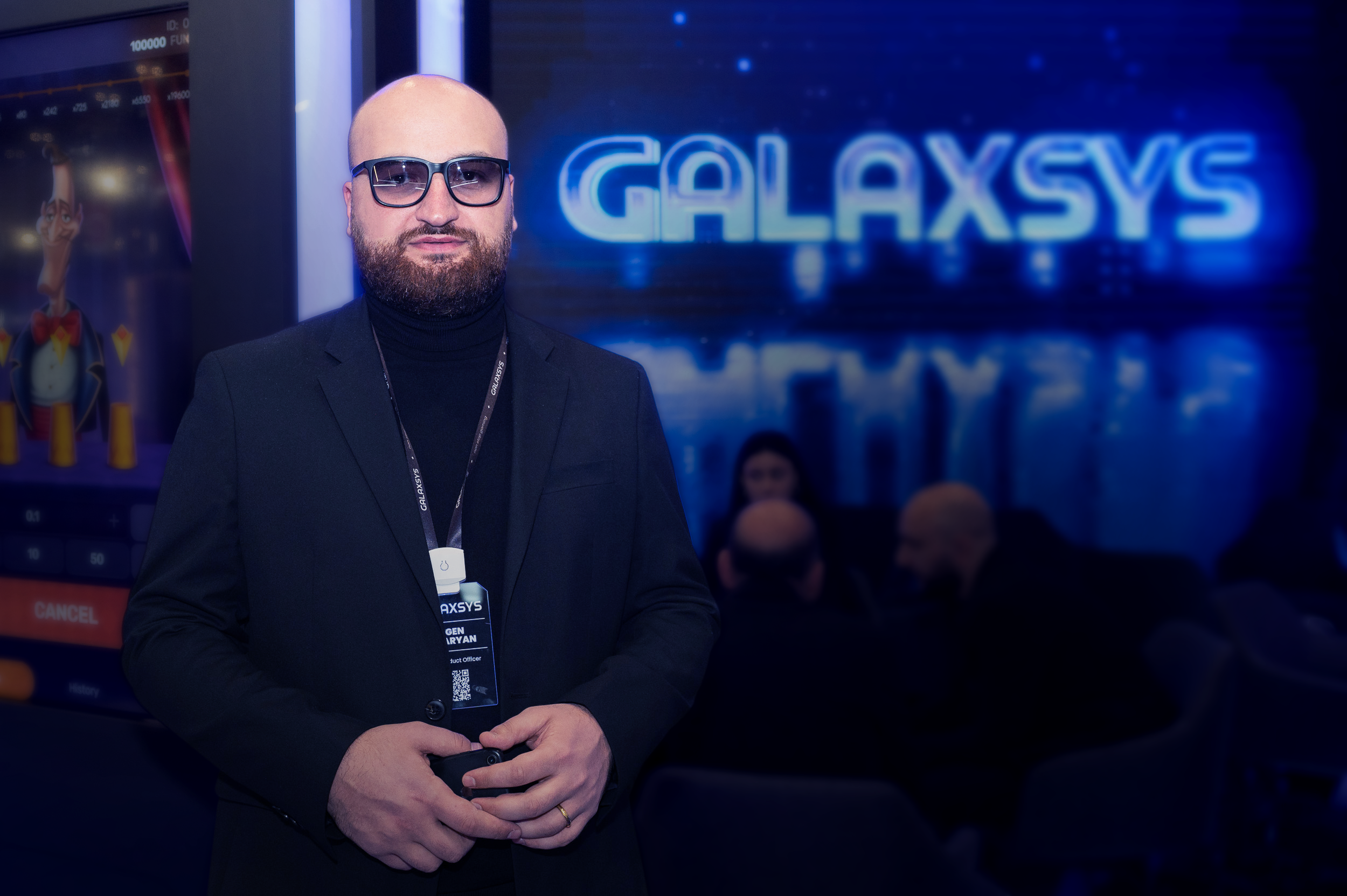Panellists:
Vigen Safaryan, chief product officer, Galaxsys
Danielle Calafato, chief commercial officer, Gaming Corps
Anna Vikmane, director, BETER Live
Julian Borg-Barthet, chief commercial officer, Lady Luck Games
What challenges did you face coming into a competitive market?
Galaxsys: To gain a competitive advantage, companies must address several key challenges. First, building a brand that stands out from competitors is crucial. This involves creating a clear brand message and offering unique features to differentiate products.
Compliance with local and international regulations is also essential to avoid legal issues and financial penalties. Companies must obtain gambling licences and adhere to payment regulations.

Gaming Corps: The first thing we had to do was reach out to the market and secure time in front of operators. You can’t take something to a top-tier operator that doesn’t hit the mark and expect another opportunity. You need a USP that drives interest in your games, while also understanding your customer and what they’re looking for.
Finally, competition is intense, and companies must continually innovate and differentiate their products to stay ahead. Research and development, industry trend monitoring, and understanding customer preferences are crucial.
I would also say one of the more expensive resources early on for any studio is compliance costs. The delays can be costly, and maintaining trust with operators is vital.
BETER Live: Across the past five years, the live casino industry has expanded significantly. More and more confident and competitive players are entering this market and providing quality services. As a new live content provider, we wanted to come into the market with strong USPs and even stronger products. This has meant striking the balance between developing and releasing core, classic live table games that are simply better quality than those offered by our rivals, and bringing innovations and never-seen-before concepts to the table.
Lady Luck: I’d say the biggest challenge has been to ensure we are heard above the noise being made by our competitors in what is a saturated and competitive market. We also have a wide-reaching network that we have been able to tap into, but once we have been at the table, we’ve still had to showcase why an operator should stock our games.
Another big challenge has been regulation and licensing. The vast majority of operators won’t even consider having a conversation with a studio if you do not hold a licence from key jurisdictions such as Malta and the UK.
How has your content given you cut-through and how has it developed since you first came to market?
Galaxsys: Since entering the market, our content has evolved to offer a wider range of games, including crash-type games, turbo games, card games, and new, cutting-edge titles.
Overall, our focus on quality, innovation, and responsible gaming has enabled us to stand out in a competitive market and gain a loyal customer base. By continually investing in our content, we remain committed to delivering exceptional gaming experiences to our players.
Gaming Corps: We started out in mainstream gaming, although that was some time ago now. We started by making slot games, pivoting briefly to instant win content like Mine and Crash games, where we knew there was a gap in the market and we could be competitive.
We also produced table games that allowed customisation, from skin tone options on the 3D hand animation through to customer branding.
Then we were then able to action the goal of bringing in new people. Ultimately, this brought us almost full circle and back to the development of competitive slot development.
BETER Live: We have used cutting-edge technologies and the latest code to build the foundation of our portfolio, with core table games such as blackjack and roulette, combined with new product verticals such as gameshows. Our strong technical base gives us the platform to do this.

Lady Luck: We have always aimed to strike the balance between being different while also developing games that players want to play. We listen to the feedback we receive from our partners and their players, and ensure it is implemented across our product roadmap. Part of our job as a developer is to bring new ideas and concepts to the market that take players by surprise, so we are always trying to seek conformity while at the same time trying to break it.
How do you think the value of branded content compares to original content?
Galaxsys: When it comes to online gaming, both branded and original content can be effective in attracting and retaining customers. Branded content can help promote new games or features while maintaining brand consistency, while original content can provide a unique and engaging gaming experience. The key is to strike a balance between branded and original content to ensure the content strategy aligns with the overall business objectives. By leveraging both types of content effectively, online gaming providers can differentiate themselves from the competition and build a loyal customer base.
Gaming Corps: In terms of branded IP content, it’s not something we do right now. Dealing with IP holders can impact your ability to actually produce the game you intended and it takes additional time that, as a small team, isn’t our focus at the moment.
Original content, however, hits the desire for operators to offer something no-one else can. If you want Raging Zeus, it’s a Gaming Corps title, so it requires working with us directly or via one of the many aggregation partners we have.
This can work for all sides, because if a player is successful playing a casino brand’s Plinko or Coin Miner, it feeds into potential retention for the operator, on a game that nobody else can offer.
BETER Live: I think it’s important to define the two types of live branded content that operators can offer. The first is games based around a brand/theme, such as the World Cup, and the second is dedicated studios/tables that incorporate their branding (logos, colors, etc.).
Both offer massive opportunities, but especially for operators that roll out dedicated tables. Players are drawn to these titles because of the affinity they have with the brand, but also because of the personalised experience they receive. Many get to know the dealers, and this becomes part of why they play certain games at certain times.
Lady Luck: I am a strong believer in branded content. Brand recognition will always attract new players to dive into the unfamiliar, because it is set within the comfort of something they recognise. The first slots I gravitated towards were branded slots. I didn’t know how to play them but felt comfort in interacting with something I was familiar with.
I think where most studios fail is when they believe branding is the only thing that will carry the game, but it isn’t. Branded content is something to have fun with, but to also use as the foundation to do something that also plays well via the mechanics and the story you can tell within that theme. If you’re not doing that, then you are just making another skin.
To what extent has seasonal content helped improve your offering and what long-term value do these games offer?
Gaming Corp: From a studio’s perspective, you’re always looking to serve content when the audience is most receptive, making sure the day and date a game is released is something that is considered with your audience in mind. There are multiple games on offer for special occasions, but fewer than there are general releases, so your competition is arguably lessened. If your content is good, the chances are by having seasonal content, you and your customer can see better rewards over these periods.
BETER Live: There’s a lot that can be done with branded games, and seasonal content fits into that. This is certainly the case around major events like Christmas and Halloween, as well as specific sports and tournaments. These can be big acquisition opportunities if operators combine themed tables with well-targeted marketing campaigns and promotions.
What are the current trends in casino games/live casino you need to be aware of?
Galaxsys: There are five main current trends we see. The first is mobile-first gaming. It is important to ensure our games are optimised for mobile platforms. The second is Crash-type games, and this will likely be a trend for at least the next three years.
Then there is live casino; we need to continue to offer a wide variety of live dealer games. Personalised gaming experiences are also becoming increasingly important, and we need to use data analytics to tailor our games to each individual player’s preferences.
The final trend is cryptocurrency: Bitcoin and Ethereum are gaining wider acceptance, and we need to offer cryptocurrency payments.
Gaming Corps: There are two things we really need to be aware of. The first is localisation and tailoring to audience preferences.

The second is customisation. We see more and more tailoring of an individual player’s lobby view. By this I mean where a player sees their favourite content first, at least for customers that aren’t restricted by factors such as legacy technology.
Then there’s going to be an interesting discussion regarding volatility, like whether the player looking for higher volatility titles or operator looking to cap their exposure wins out longer term.
BETER Live: There are two big trends right now. The first is the rise of gameshow titles and the second is the preference among a growing player audience for games and tables offering lower stakes.
Live gameshow titles have significant appeal among the next generation of players that operators are looking to engage, and they also open up significant cross-sell opportunities too. When it comes to smaller stakes and lower bet limits, this aligns with the increasing prevalence of casual players and more consumers trying live casino for the first time, but that want to take it steady. They are looking for affordable entertainment, and live gameshow titles with small stakes certainly provide this.
Where do you think casino games/live casino can improve and what kind of innovations do you think we will see in this space in the coming years?
Galaxsys: First, I think by incorporating more gamification elements into casino games and live casino, we can increase engagement and loyalty.
Second, VR and AR technologies offer a highly-immersive gaming experience. We expect to see more VR and AR-powered casino games and live casino features.
Then there is social gaming, which is becoming increasingly popular. We are likely to see more social gaming features incorporated into casino games and live casinos.
Finally, responsible gaming is becoming more important, and we anticipate more features and tools introduced to help players manage their gaming habits and promote responsible gaming.
Gaming Corps: I believe there is finally a consensus from providers and operators that there is real value in offering alternative types of product. When you look at the slots space and put the most innovative product of today next to a game from 15 years ago, how much has truly changed beyond the game aesthetically looking a lot more modern and polished?
If we look at mobile gaming, we can see a big trend over the last five years where social elements are becoming increasingly popular; things like sharing your wins or communicating in a live channel. Live casino has begun to take shape recently to include this, but casino games are only just moving in that direction.
BETER Live: When it comes to live content, the sky really is not the limit and I think we will see great strides taken with the gameshow format. Of course, such is the scope of what can be done with live content, I think we could ultimately see new formats land in operator lobbies, including live crash games.
Lady Luck: The problem with innovation is it always leaves a portion of the market behind. Just because I can afford to play and want to play does not mean that I can access a live dealer studio on the go; even in the UK, mobile infrastructure is limited and not consistent. Socially, I want to play on my own terms and that is fast and discreetly on my phone.
Also, disabilities are wide-ranging, and the most common is sight impairment, so this means everything should be crystal clear, easy to find, and highly entertaining. This might not be the sort of innovation we often talk about, but for me, it’s just as important as new pay ways, crazy mechanics and big bonuses.
Going forward, how do you see player habits and trends developing across the next five years? How will you update your offering to cater for this?
Galaxsys: Across the next five years, we expect to see trends such as mobile gaming, personalisation, booming of crash type games, social gaming, cryptocurrency payments, and responsible gaming continue to develop.
Gaming Corps: Right now, there’s a lot of catering towards a market who love to share their big wins, whether it be on social media via pictures or live-streaming, but it’s still real-money gaming, so that won’t be the case for all players.

Overall, it has led to a lot of developers creating games with greater volatility. Games teams need to understand how to balance the needs of the player with the commercial team’s experience of what customers are looking for.
BETER Live: I think the way in which an audience communicates and interacts will evolve. But what makes live so special is that we have the human connection that other gaming verticals simply don’t have. It’s my personal belief players will continue to seek out entertainment options that allow them to chat and interact with others.
Lady Luck: For the time being at least, we are not seeing catalysts that lead to a drastic change of direction for the industry as a whole, such as mobile asserting its dominance over desktop. Things like augmented reality and the Metaverse are on a slow burner and are still very much for a niche audience. This means studios can focus on taking the current stable of casino content in their portfolios to the next level and creating new, exciting entertainment experiences that get player pulses racing.
Original article: https://igamingbusiness.com/casino-games/gaming-the-changing-face-of-games-studios/














